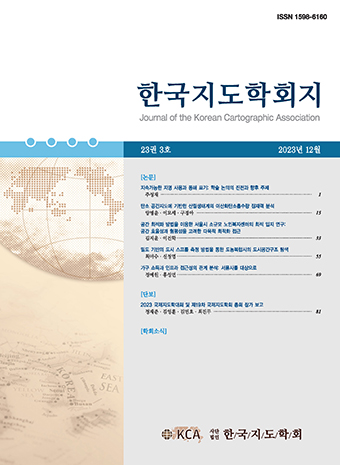Research Article
Abstract
References
Information
This study aims to compare Geographically Weighted Regression (GWR) model with Multi-scale Geographically Weighted Regression (MGWR) model by utilizing the number of COVID-19 confirmed cases and factors influencing them. First, this study investigated factors that mainly affect the increase of COVID-19 confirmed cases. Next, Ordinary Least Square, Variation Inflation Factor, and Local Moran’s I were applied to explore the linear relationship and local spatial autocorrelation between COVID-19 confirmed cases and the major factors. In particular, this study compared results of the GWR model with the most recently proposed MGWR model. Regarding bandwidth, the MGWR model uses different spatial scales which are determined by mitigating the local collinearity issues found in a standard GWR and narrowing the range of values. As a result, MGWR is more stable than GWR. Consequently, we expect the study can contribute to the EISS for infectious diseases that require quarantine, prevention, and prediction.
본 연구는 코로나-19 확진자 수와 이에 영향을 미치는 요인들을 활용하여 지리가중회귀(Geographically Weighted Regression, GWR)모델과 다중스케일 지리가중회귀(Multi-scale Geographically Weighted Regression, MGWR)모델을 비교 분석하는데 목적이 있다. 가장 먼저 선행 연구조사를 통해 코로나-19 확진자 수에 커다란 영향을 미치는 요인들을 선별하였다. 다음으로 최소제곱법(Ordinary Least Square, OLS), 분산팽창계수(Variation Inflation Factor, VIF)및 Local Moran’s I를 사용하여 코로나-19 확진자 수와의 선형 및 국지적 공간자기상관관계를 탐색하였다. 특히 종전에 널리 사용되어왔던 GWR모델과 최근 새롭게 등장한 MGWR모델을 비교 분석하여 본 연구에 가장 적합한 지리가중회귀 모델을 결정하였다. MGWR은 변수 특성을 감안한 조정된 밴드대역폭을 사용하여 보다 정밀하게 변수들 간의 공간관계를 설명할 수 있다. 본 연구를 통해 얻은 결과물은 감염병 예방 및 예측에 필요로 하는 감염병역학조사지원시스템에 도움을 줄 수 있을 것으로 기대한다.
- 김현・이금숙・이영현・송예나, 2021, "COVID-19 시기의 음식점 개폐점 연구-서울시를 사례로," 대한지리학회지, 56(1), 35-51. 10.22776/kgs. 2021.56.1.35
- 박현준・임륭혁・조용래, 2020, "COVID-19 확진자 이동경로의 특성과 시사점 -한국 경기도를 중심으로-," 과학기술정책, 3(2), 67-95. 10.35224/kapd.2019.19.1.004
- 안재성・최진무・이상원・함정수, 2020, "시공간 자료 지리적 시각화를 통한 코로나바이러스감염증-19 확진자 시공간 이동경로 분석에 관한 연구," 한국지도학회지, 20(3), 13-22. 10.16879/jkca. 2020.20.3.013
- 이유빈, 2021, "감염병 의료시설 접근성 및 확진자 발생 지역요인 분석," 국내석사학위논문, 경희대학교 대학원.
- 이창환・기모란, 2015, "한국의 감염병 역학조사 강화방안: 중동호흡기증후군 유행 경험에서의 교훈," 대한의사협회지, 58(8), 706-713. 10.5124/ jkma.2015.58.8.706
- 이채현・하은혜・김감영, 2021, "COVID-19 팬데믹의 지도화 동향에 대한 비판적 검토," 한국지도학회지, 21(2), 13-28. 10.16879/jkca.2021. 21.2.013
- 천명선, 2006, "근대 역학의 시작과 백신의 개발," 대한수의사학회지, 42(5), 471-476. 10.1109/JQE.2006.873150
- 홍일영・전보애・이경주, 2014, "공간가중회귀모형을 이용한 18 대 대선 투표율 및 지지율과 인구사회학 변수들 간의 공간관계 분석," 한국지도학회지, 14(3), 55-71. http://dx.doi.org/10.16879/jkca.2014.14.3.000 10.16879/jkca.2014.14.3.055
- Acharya, R. and Porwal, A., 2020, A vulnerability index for the management of and response to the COVID-19 epidemic in India: An ecological study,
The Lancet Global Health , 8(9), e1142-e1151. 10.1016/S2214-109X(20)30300-4 - Andersen, L.M., Harden, S.R., Sugg, M.M., Runkle, J.D., and Lundquist, T.E, 2021, Analyzing the spatial determinants of local COVID-19 transmission in the United States,
Science of the Total Environment , 754, 142396. 10.1016/j.scitotenv.2020.142396 - Anselin, L., 1995, Local indicators of spatial association - LISA,
Geographical Analysis , 27(2), 93-115. 10.1111/j.1538-4632.1995.tb00338.x - Anselin, L., 2001, Spatial econometrics, in Baltagi, B.H. ed.,
A Companion to Theoretical Econometrics , 310-330. 10.1002/9780470996249.ch15 - Boehmer, T.K., DeVies, J., Caruso, E., van Santen, K.L., Tang, S., Black, C.L., Hartnett, K.P., Kite-Powell, A., Dietz, S., Lozier, M., and Gundlapalli, A.V., 2020, Changing age distribution of the COVID-19 pandemic-United States, May-August 2020,
Morbidity and Mortality Weekly Report , 69(39), 1404. 10.15585/mmwr.mm 6939e1 - Brunsdon, C., Fotheringham, A.S., and Charlton, M.E., 1996, Geographically weighted regression: A method for exploring spatial nonstationarity,
Geographical Analysis , 28(4), 281-298. 10.1111/j.1538-4632.1996.tb00936.x - De Ángel Solá, D.E., Wang, L., Vázquez, M., and Méndez‐Lázaro, P.A., 2020, Weathering the pandemic: How the Caribbean Basin can use viral and environmental patterns to predict, prepare, and respond to COVID‐19,
Journal of Medical Virology , 92(9), 1460-1468. 10.1002/jmv.25864 - Dutta, I., Basu, T., and Das, A., 2021, Spatial analysis of COVID-19 incidence and its determinants using spatial modeling: A study on India,
Environmental Challenges , 4, 100096. 10.1016/j.envc.2021.100096 - Ehlert, A., 2021, The socio-economic determinants of COVID-19: A spatial analysis of German county level data,
Socio-Economic Planning Sciences , 101083. 10.1016/j.seps.2021.101083 - Fotheringham, A.S., Yang, W., and Kang, W., 2017, Multiscale geographically weighted regression (MGWR),
Annals of the American Association of Geographers , 107(6), 1247-1265. 10.1080/24694452.2017.1352480 - Franch-Pardo, I., Napoletano, B.M., Rosete-Verges, F., and Billa, L., 2020, Spatial analysis and GIS in the study of COVID-19. A review,
Science of The Total Environment , 739, 140033. 10.1016/j.scitotenv.2020.140033 - Goodchild, M.F., 2001, Models of scale and scales of modelling,
Modelling Scale in Geographical Information Science , 3-10. - Harris, R., Singleton, A., Grose, D., Brunsdon, C., and Longley, P., 2010, Grid‐enabling geographically weighted regression: A case study of participation in higher education in England,
Transactions in GIS , 14(1), 43-61. 10.1111/j.1467-9671.2009.01181.x - Hassaan, M.A., Ghazy, R.M., Abdelwahab, R.G.A., and Elbarky, T.A., 2021, GIS-Based analysis framework for identifying COVID-19 incidence and fatality determinants at national level case study: Africa,
MedRxiv . 10.1101/2021.01.12.21249661 - Hutchins, H.J., Wolff, B., Leeb, R., Ko, J.Y., Odom, E., Willey, J., Friedman, A., and Bitsko, R.H., 2020, COVID-19 mitigation behaviors by age group-United States, April-June 2020,
Morbidity and Mortality Weekly Report , 69(43), 1584. 10.15585/mmwr.mm6943e4 - Kim, S., Lee, S., Ko, E., Jang, K., and Yeo, J., 2021, Changes in car and bus usage amid the COVID-19 pandemic: Relationship with land use and land price,
Journal of Transport Geography , 96, 103168. 10.1016/j.jtrangeo.2021.103168 - Leong, Y.Y. and Yue, J.C., 2017, A modification to geographically weighted regression,
International Journal of Health Geographics , 16(1), 1-18. 10.1186/s12942-017-0085-9 - Li, Z., Fotheringham, A.S., Li, W., and Oshan, T., 2019, Fast Geographically Weighted Regression (FastGWR): A scalable algorithm to investigate spatial process heterogeneity in millions of observations,
International Journal of Geographical Information Science , 33(1), 155-175. 10.1080/13658816.2018.1521523 - Li, Z., and Fotheringham, A.S., 2020, Computational improvements to multi-scale geographically weighted regression,
International Journal of Geographical Information Science , 34(7), 1378-1397. 10.1080/13658816.2020.1720692 - Maiti, A., Zhang, Q., Sannigrahi, S., Pramanik, S., Chakraborti, S., Cerda, A., and Pilla, F. , 2021, Exploring spatiotemporal effects of the driving factors on COVID-19 incidences in the contiguous United States,
Sustainable Cities and Society , 68, 102784. 10.1016/j.scs.2021.102784 - Malik, A.A., McFadden, S.M., Elharake, J., and Omer, S.B., 2020, Determinants of COVID-19 vaccine acceptance in the US,
EClinicalMedicine , 26, 100495. 10.1016/j.eclinm.2020.100495 - Mansour, S., Al Kindi, A., Al-Said, A., Al-Said, A., and Atkinson, P., 2021, Sociodemographic determinants of COVID-19 incidence rates in Oman: Geospatial modelling using multiscale geographically weighted regression (MGWR),
Sustainable Cities and Society , 65, 102627. 10.1016/j.scs.2020.102627 - Mollalo, A. and Tatar, M., 2021, Spatial modeling of COVID-19 vaccine hesitancy in the United States,
International Journal of Environmental Research and Public Health , 18(18), 9488. 10.3390/ijerph18189488 - Mollalo, A., Vahedi, B., and Rivera, K.M., 2020, GIS-based spatial modeling of COVID-19 incidence rate in the continental United States,
Science of the Total Environment , 728, 138884. 10.1016/j.scitotenv.2020.138884 - Moore, D.A., and Carpenter, T.E., 1999, Spatial analytical methods and geographic information systems: Use in health research and epidemiology,
Epidemiologic Reviews , 21(2), 143-161. 10.1093/oxfordjournals.epirev.a017993 - Oshan, T.M., Li, Z., Kang, W., Wolf, L.J., and Fotheringham, A.S., 2019, Mgwr: A python implementation of multiscale geographically weighted regression for investigating process spatial heterogeneity and scale,
ISPRS International Journal of Geo-Information , 8(6), 269. 10.3390/ijgi8060269 - Oshan, T.M., Smith, J.P., and Fotheringham, A.S., 2020, Targeting the spatial context of obesity determinants via multiscale geographically weighted regression,
International Journal of Health Geographics , 19(1), 1-17. 10.1186/s12942-020-00204-6 - Pohlmann J., and Leitner, D., 2003, A comparison of ordinary least squares and logistic regression,
Ohio Journal of Science , 103(5), 118-125. - Robinson, C. and Schumacker, R.E., 2009, Interaction effects: Centering, variance inflation factor, and interpretation issues,
Multiple Linear Regression Viewpoints , 35(1), 6-11. - Samany, N.N., Toomanian, A., Maher, A., Hanani, K., and Zali, A.R., 2021, The most places at risk surrounding the COVID-19 treatment hospitals in an urban environment-case study: Tehran city,
Land Use Policy , 109, 105725. 10.1016/j.landusepol.2021.105725 - Sannigrahi, S., Pilla, F., Basu, B., Basu, A.S., and Molter, A., 2020, Examining the association between socio-demographic composition and COVID-19 fatalities in the European region using spatial regression approach,
Sustainable Cities and Society , 62, 102418. 10.1016/j.scs.2020.102418 - Shabrina, Z., Buyuklieva, B., and Ng, M.K.M., 2020, Short‐term rental platform in the urban tourism context: A geographically weighted regression (GWR) and a multiscale GWR (MGWR) approaches,
Geographical Analysis , 53(4), 686-707. 10.1111/gean.12259 - Snyder, B.F., and Parks, V., 2020, Spatial variation in socio-ecological vulnerability to Covid-19 in the contiguous United States,
Health & Place , 66, 102471. 10.1016/j.healthplace.2020.102471 - Sy, K.T.L., Martinez, M.E., Rader, B., and White, L.F., 2021, Socioeconomic disparities in subway use and COVID-19 outcomes in New York City,
American Journal of Epidemiology , 190(7), 1234-1242. 10.1093/aje/kwaa277 - Tobler, W.R., 1970, A computer movie simulating urban growth in the detroit region,
Economic Geography , 46(sup1), 234-240. 10.2307/143141 - Tomal, M., 2021, Exploring the meso-determinants of apartment prices in Polish counties using spatial autoregressive multiscale geographically weighted regression,
Applied Economics Letters , 1-9. 10.1080/13504851.2021.1891194 - United Nations, 2020, UN Research Roadmap for the COVID-19 Recovery.
- Xiong, Y., Wang, Y., Chen, F., and Zhu, M., 2020, Spatial statistics and influencing factors of the novel coronavirus pneumonia 2019 epidemic in Hubei province, China,
Research Square . https:// doi.org/10.21203/rs.3.rs-16858/v2 10.21203/rs.3.rs-16858/v2 - Zhang, X., Rao, H., Wu, Y., Huang, Y., and Dai, H., 2020, Comparison of spatiotemporal characteristics of the COVID-19 and SARS outbreaks in mainland China.
BMC Infectious Diseases , 20(1), 1-7. 10.1186/s12879-020-05537-y - 국토정보플랫폼, "수치지도", http://map.ngii.go.kr/ms/map/NlipMap.do(2021.11 검색)
- 보건의료 빅데이터 개방시스템, "전국 병의원 및 약국 현황", https://opendata.hira.or.kr/op/opc/selectOpen Data.do?sno=11925&publDataTpCd=&searchCnd=&searchWrd=%EB%B3%91%EC%9B%90&pageIndex=2(2021.11 검색)
- 서울시, "코로나-19(COVID-19)", https://www.seoul.go.kr/ coronaV/coronaStatus.do(2021.11 검색)
- 서울 열린 데이터광장, "서울시 주민등록인구(구별) 통계, https://data.seoul.go.kr/dataList/419/S/2/datasetView.do(2021.11 검색)
- 서울 열린 데이터광장, "서울시 지하철호선별 역별 승하차 인원 정보", https://data.seoul.go.kr/dataList/ OA-12914/S/1/datasetView.do(2021.11 검색)
- 서울 열린 데이터광장, "서울특별시 코로나19 자치구별 확진자 발생동향", https://data.seoul.go.kr/dataList/ OA-20470/S/1/datasetView.do(2021.11 검색)
- 중앙재난안전대책본부, 2021, 보도자료: 단계적 일상회복 이행계획 발표.
- 질병관리청, 2021, 코로나바이러스감염증-19(COVID-19), http://ncov.mohw.go.kr/(2021.11 검색)
- 질병관리청, 2021, 코로나바이러스감염증-19(COVID-19), "국내 발생 현황", http://ncov.mohw.go.kr/bdBoardList_Real.do?brdId=1&brdGubun=11&ncvContSeq=&contSeq=&board_id=&gubun= (2021.11 검색)
- Publisher :The Korean Cartographic Association
- Publisher(Ko) :한국지도학회
- Journal Title :Journal of the Korean Cartographic Association
- Journal Title(Ko) :한국지도학회지
- Volume : 21
- No :3
- Pages :77-91
- DOI :https://doi.org/10.16879/jkca.2021.21.3.077



 Journal of the Korean Cartographic Association
Journal of the Korean Cartographic Association





